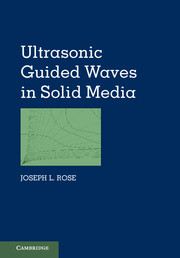Book contents
- Frontmatter
- Contents
- Nomenclature
- Preface
- Acknowledgments
- 1 Introduction
- 2 Dispersion Principles
- 3 Unbounded Isotropic and Anisotropic Media
- 4 Reflection and Refraction
- 5 Oblique Incidence
- 6 Waves in Plates
- 7 Surface and Subsurface Waves
- 8 Finite Element Method for Guided Wave Mechanics
- 9 The Semi-Analytical Finite Element Method
- 10 Guided Waves in Hollow Cylinders
- 11 Circumferential Guided Waves
- 12 Guided Waves in Layered Structures
- 13 Source Influence on Guided Wave Excitation
- 14 Horizontal Shear
- 15 Guided Waves in Anisotropic Media
- 16 Guided Wave Phased Arrays in Piping
- 17 Guided Waves in Viscoelastic Media
- 18 Ultrasonic Vibrations
- 19 Guided Wave Array Transducers
- 20 Introduction to Guided Wave Nonlinear Methods
- 21 Guided Wave Imaging Methods
- Appendix A Ultrasonic Nondestructive Testing Principles, Analysis, and Display Technology
- Appendix B Basic Formulas and Concepts in the Theory of Elasticity
- Appendix C Physically Based Signal Processing Concepts for Guided Waves
- Appendix D Guided Wave Mode and Frequency Selection Tips
- Index
- Plates
- References
3 - Unbounded Isotropic and Anisotropic Media
Published online by Cambridge University Press: 05 July 2014
- Frontmatter
- Contents
- Nomenclature
- Preface
- Acknowledgments
- 1 Introduction
- 2 Dispersion Principles
- 3 Unbounded Isotropic and Anisotropic Media
- 4 Reflection and Refraction
- 5 Oblique Incidence
- 6 Waves in Plates
- 7 Surface and Subsurface Waves
- 8 Finite Element Method for Guided Wave Mechanics
- 9 The Semi-Analytical Finite Element Method
- 10 Guided Waves in Hollow Cylinders
- 11 Circumferential Guided Waves
- 12 Guided Waves in Layered Structures
- 13 Source Influence on Guided Wave Excitation
- 14 Horizontal Shear
- 15 Guided Waves in Anisotropic Media
- 16 Guided Wave Phased Arrays in Piping
- 17 Guided Waves in Viscoelastic Media
- 18 Ultrasonic Vibrations
- 19 Guided Wave Array Transducers
- 20 Introduction to Guided Wave Nonlinear Methods
- 21 Guided Wave Imaging Methods
- Appendix A Ultrasonic Nondestructive Testing Principles, Analysis, and Display Technology
- Appendix B Basic Formulas and Concepts in the Theory of Elasticity
- Appendix C Physically Based Signal Processing Concepts for Guided Waves
- Appendix D Guided Wave Mode and Frequency Selection Tips
- Index
- Plates
- References
Summary
Introduction
Bulk wave propagation refers to wave propagation in infinite media; guided waves are those that require a boundary for their existence, such as surface waves, Lamb waves, and interface waves. This chapter will focus on bulk wave propagation in infinite (or semi-infinite) media. Keep in mind that a thin structure can, for all practical purposes, still be considered a half-space or semi-infinite media if the wavelength of excitation is small with respect to the thickness of the test object.
We shall explore some interesting phenomena of phase velocity variation with angle of propagation into solid media. This leads to a dispersive influence as a result of differences in phase velocity and energy velocity. For isotropic materials, phase velocity is independent of entry angle. For lossless media, the energy velocity is equal to the group velocity. However, because of the wave velocity variations with angle, interference phenomena will lead to a skew angle. Trying to send waves or ultrasonic energy in a specific direction may be more difficult than you think!
Information
- Type
- Chapter
- Information
- Ultrasonic Guided Waves in Solid Media , pp. 36 - 52Publisher: Cambridge University PressPrint publication year: 2014
